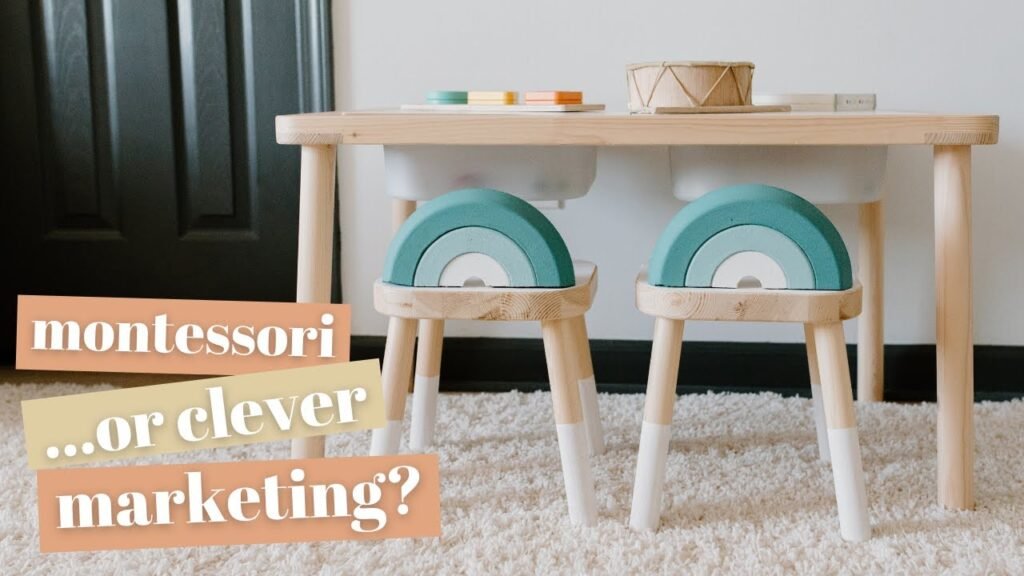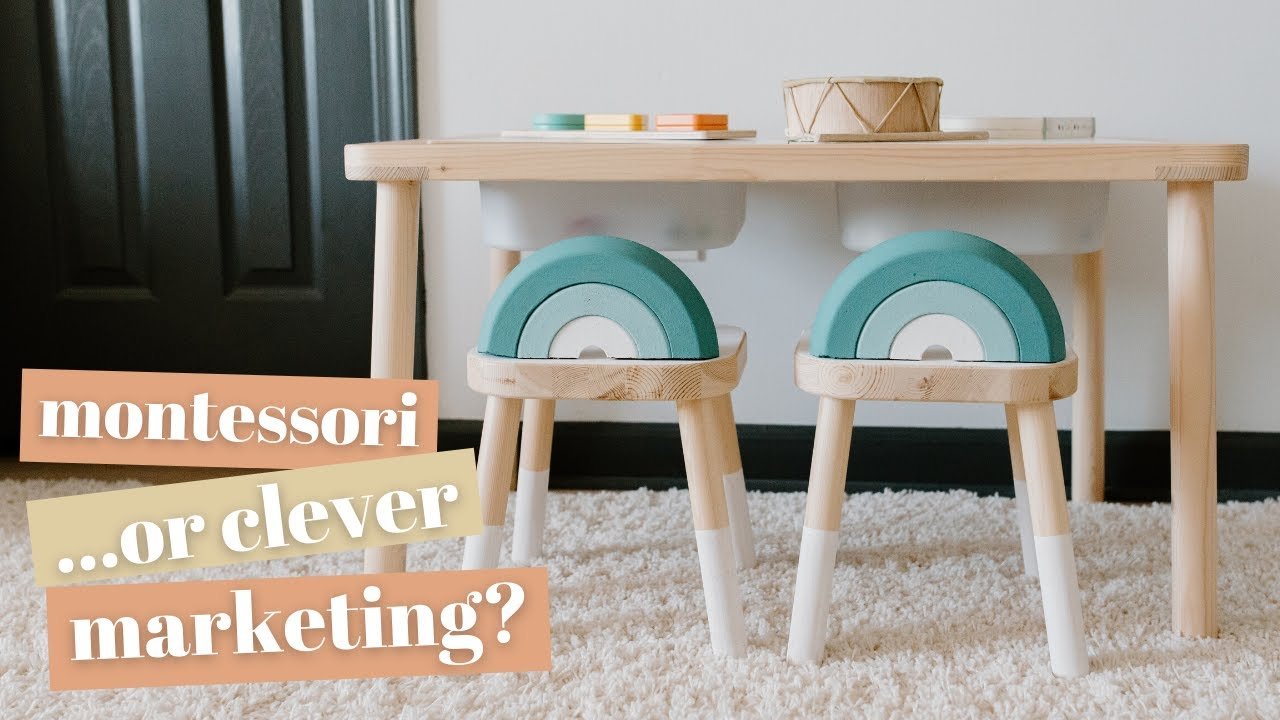Hi there! My name is Ashley, and I’m a mom of two little girls, Kylie and Mia. Today, I want to address a question that many Montessori parents have been asking – how do you tell if a toy or activity is truly Montessori or just clever marketing? It can be quite confusing since the term “Montessori” is not trademarked, allowing any company to use it in their product names and marketing. In this video by Hapa Family, they discuss the challenge of finding authentic Montessori materials and provide some guidance on how to identify them. They also mention a recommended website, Neon House, for browsing and searching for authentic Montessori materials. Additionally, the video explores the concept of Montessori-inspired materials, which are variations of authentic materials that still align with Montessori principles. Throughout the video, key qualities to look for in Montessori materials are highlighted, such as simplicity, natural materials, focus on one skill at a time, and control of error. By the end of the video, viewers are encouraged to have a discerning eye and consider these principles when evaluating toys and activities. So, if you’re a Montessori parent looking for guidance on finding authentic materials, this video is definitely worth a watch!
The Montessori Education Debate
Montessori education has gained popularity in recent years for its child-centered approach and emphasis on independent learning. However, the term “Montessori” is not trademarked, leading to confusion and misleading marketing. As a parent, it can be challenging to navigate through the sea of products and determine if they are truly aligned with Montessori principles. In this article, we will explore how to identify authentic Montessori materials and provide recommendations for resources that can help you in your search.

What is Montessori?
Montessori education is an educational approach developed by Dr. Maria Montessori in the early 20th century. It emphasizes the importance of self-directed learning, hands-on exploration, and individualized instruction. The goal of Montessori education is to promote independence, creativity, and a love for learning in children. Montessori materials play a crucial role in this educational method, as they are designed to encourage active engagement and the development of specific skills.
Confusion and Misleading Marketing
One of the biggest challenges in finding Montessori materials is the lack of trademark or copyright protection for the term “Montessori.” This means that any company can use the word “Montessori” in the name of its toy or activity and market it as such, even if it does not align with Montessori principles. This can be misleading for parents who are trying to find materials that are truly authentic.
To avoid falling into the trap of misleading marketing, it is essential to have a discerning eye and look beyond the label. Instead, focus on the qualities and characteristics of the materials that align with Montessori principles. This will help you determine if a product is genuinely Montessori or just clever marketing.
Finding Authentic Montessori Materials
Identifying authentic Montessori materials can be challenging, especially for parents who are new to the Montessori method. However, there are key qualities that can help you distinguish between authentic materials and those that are not aligned with Montessori principles.
Key Qualities of Montessori Materials
-
Simplicity: Montessori materials are designed to be simple and uncluttered, allowing children to focus on the specific skill being taught. They often have a minimalistic design and do not feature distracting elements.
-
Natural Materials: Montessori materials are typically made from natural materials such as wood, metal, or fabric. This is because Montessori emphasizes the importance of using natural and sensory-rich materials in order to connect children with the world around them.
-
Based in Reality: Montessori materials are designed to be realistic and representative of objects found in the real world. This helps children make connections between their learning and the world around them.
-
Focus on One Skill: Montessori materials are usually designed to isolate and develop specific skills or concepts. They allow children to practice a single skill at a time, promoting deep understanding and mastery.
-
Control of Error: Authentic Montessori materials have a built-in control of error, meaning that children can correct their own mistakes without the need for adult intervention. This promotes independence and self-correction.
Examples of Non-Montessori Materials
To better understand what is considered non-Montessori, let’s take a look at some examples:
-
Overstimulating Toys: Toys that have flashing lights, loud sounds, and excessive features can overstimulate children and hinder their ability to focus and engage in meaningful learning experiences.
-
Educational Toys with Letters and Numbers: While educational toys can be beneficial, those that focus solely on letters and numbers without considering other important aspects of learning may not align with Montessori principles.
-
Wooden Stackers with Unrelated Themes: Wooden stackers with themes unrelated to Montessori principles, such as cartoon characters or fantasy creatures, may not provide the same learning opportunities as Montessori-inspired materials.
It is important to remember that non-Montessori materials are not necessarily bad or worthless. They may still offer entertainment, enjoyment, and even educational value. However, they may not fully align with the principles and goals of Montessori education.
Recommended Resources
When searching for authentic Montessori materials, it can be helpful to have access to reliable resources. Here are some recommended resources that can assist you in your search:
Recommended Reading Materials
Reading books related to Montessori education can deepen your understanding of the principles and provide guidance on choosing appropriate materials. Some recommended reading materials include:
- “The Montessori Toddler: A Parent’s Guide to Raising a Curious and Responsible Human Being” by Simone Davies
- “Montessori from the Start: The Child at Home, from Birth to Age Three” by Paula Polk Lillard and Lynn Lillard Jessen
- “Montessori: The Science Behind the Genius” by Angeline Stoll Lillard
These books offer valuable insights into the Montessori method and can help you make informed decisions when selecting materials for your child.
Certified Montessori Suppliers
Certified Montessori suppliers are a reliable source for authentic Montessori materials. These suppliers follow specific blueprints provided by organizations such as the Association Montessori Internationale (AMI) to create materials that adhere to Montessori principles. One certified Montessori supplier that comes highly recommended is Neon House. They provide a wide range of Montessori materials for different age groups and offer detailed descriptions and photos to help you make informed choices.
Neon House
Neon House is a reputable online platform that offers an extensive selection of Montessori materials. They have categories for different age groups, making it easy to find materials suitable for your child’s developmental stage. Neon House follows AMI-approved blueprints when creating their materials, ensuring their authenticity and alignment with Montessori principles. Browsing their website can give you a better understanding of what authentic Montessori materials look like and assist you in identifying materials that are in line with your values.
Supporting the Creator
The Hapa Family, the creator of the video discussed, provides valuable information on Montessori education and offers recommendations for finding authentic materials. If you enjoyed their content and would like to support them, here are a few ways you can do so:
Following Hapa Family on Instagram
You can follow the Hapa Family on Instagram (@hapafamilyvlog) to stay updated on their latest content and connect with other like-minded parents. By engaging with their posts, leaving comments, and sharing their content with your own followers, you can help spread the word about their valuable insights and efforts.
Contacting Hapa Family for Business Inquiries
If you have any business inquiries or collaboration opportunities, you can reach out to the Hapa Family via email at hapafamilyvlog@gmail.com. They may be open to partnerships, sponsored content, or other business-related opportunities. Remember to provide detailed information about your proposal to ensure a more effective communication.
Supporting the Channel through Affiliate Links
In the video description, you may find affiliate links that lead to products or services recommended by the Hapa Family. Clicking on these links and making a purchase may earn the Hapa Family a small commission, at no additional cost to you. Supporting the channel through affiliate links allows the Hapa Family to continue providing free content each week and helps them maintain their commitment to delivering valuable information to the Montessori community.
Conclusion
Finding authentic Montessori materials can be challenging in a market flooded with misleading products. However, by developing a discerning eye and focusing on key qualities, you can distinguish between authentic Montessori materials and those that are not aligned with Montessori principles. Utilizing recommended resources, such as reading materials and certified Montessori suppliers like Neon House, can help you in your search.
Remember, the goal is not to dismiss non-Montessori materials as unworthy. Instead, it is about making informed choices that align with the Montessori principles and goals you have for your child. By being thoughtful and intentional in selecting materials and supporting content creators like the Hapa Family, you can create a Montessori-inspired environment that fosters independent learning, creativity, and a love for exploration in your child. Additionally, consider exploring the creator’s e-courses and book on Montessori at home, as these resources can provide further guidance and support on your Montessori journey.

